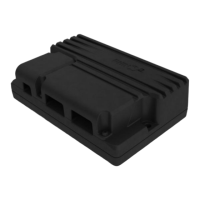Chapter 6: Appendices
Most electronic equipment is influenced by Radio Frequency Interference (RFI). Be careful
when portable communications equipment is used in the area around such equipment.
Dynamic Controls has made every effort to make sure that RFI does not change the
behaviour of the controller, but very strong signals can still cause a problem. The vehicle
manufacturer has the responsibility to make sure that the vehicle is tested according to
local EMC regulations.
Performance adjustments must only be made by healthcare professionals, or by persons
who completely understand the programming parameters, the adjustment process, the
configuration of the vehicle, and the capabilities of the driver. Wrong settings can make
the vehicle uncontrollable or unstable. An uncontrollable or unstable vehicle can cause
an unsafe situation such as a crash, with the risk of serious injury to the driver or bystanders,
or damage to the vehicle or surrounding property.
Performance adjustments must only be made indoors or outdoors in dry conditions.
Service and Configuration Warnings
The following warnings are applicable to the installation technician and the dealer or the
therapist who supplies the vehicle to the end user.
It is the responsibility of the installer to make sure that accessories that are connected to
the wires of the vehicle do not interfere with the operation of the controller.
Do not use the vehicle frame as the earth return. Any electrical low-resistance connection
to the frame is a safety risk and is not allowed by international safety standards.
If the vehicle loses electric power, it is important that an attendant is able to move the
vehicle easily.
After you have completed the installation, check it thoroughly. Correctly adjust all
programmable options before the vehicle is used.
After you have configured the vehicle, check to make sure that the vehicle performs to
the specifications entered in the programming procedure. If the vehicle does not perform
to specifications, reprogram it. Repeat this procedure until the vehicle performs to
specifications. If the wanted operation cannot be reached, contact your service agent.
After maintenance or service of the vehicle, check the functional operation of all
components that are externally connected to the controller, such as
o lights
o external switches
o actuators
o DCI/ACI/OBC resistor switch circuits
(including programmed slowdown behaviour)
The dealer, therapist or other agent who supplies the vehicle to the end user has the
responsibility to make sure that the vehicle is correctly configured for the
needs of that user.
For each individual user, the vehicle set up and configuration should take into
consideration his or her
o technical knowledge, experience and education, and
o medical and physical condition, including the level of disability and capability (where
applicable).
It is the responsibility of the OEM and installer to make sure that the maximum driving
speed of the vehicle is limited as appropriate when the vehicle is in a mechanically
unstable position, for example when the seat is raised.
It is the responsibility of the therapist/installer to minimize any risk of use error, including
those arising from ergonomic features and/or the environment in which the device is
intended to be used.
Prior to handing over the vehicle, make sure that users are fully able to operate the
product by giving them appropriate training on functionality and safety features, and
having them test-drive the vehicle in a safe area in the presence of their agent.
The controller can cause the vehicle to come to a sudden stop. If this can be dangerous
to the operator, the installer must install a seat belt and the operator must wear this belt.

